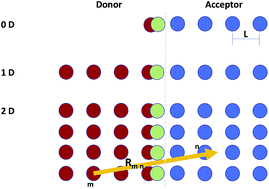当前位置:
X-MOL 学术
›
Faraday Discuss.
›
论文详情
Our official English website, www.x-mol.net, welcomes your
feedback! (Note: you will need to create a separate account there.)
Exciton dissociation and charge separation at donor-acceptor interfaces from quantum-classical dynamics simulations.
Faraday Discussions ( IF 3.3 ) Pub Date : 2019-12-16 , DOI: 10.1039/c9fd00069k Aaron Kelly 1
Faraday Discussions ( IF 3.3 ) Pub Date : 2019-12-16 , DOI: 10.1039/c9fd00069k Aaron Kelly 1
Affiliation

|
In organic photovoltaic (OPV) systems, exciton dissociation and ultrafast charge separation at donor-acceptor heterojunctions both play a key role in controlling the efficiency of the conversion of excitation energy into free charge carriers. In this work, nonadiabatic dynamics simulations based on the quantum-classical Liouville equation are employed to study the real-time dynamics of exciton dissociation and charge separation at a model donor-acceptor interface. Benchmark comparisons for a variety of low dimensional donor-acceptor chain models are performed to assess the accuracy of the quantum classical dynamics technique referred to as the forward-backward trajectory solution (FBTS). Although not always quantitative, the FBTS approach offers a reasonable balance between accuracy and computational cost. The short-time dynamics of exciton dissociation in related higher-dimensional lattice models for the interface are also investigated to assess the effect of the dimensionality on the first steps in the mechanism of charge carrier generation.
中文翻译:

量子经典动力学模拟中的供体-受体界面处的激子解离和电荷分离。
在有机光伏(OPV)系统中,激子解离和施主-受主异质结处的超快电荷分离在控制激发能转化为自由电荷载流子的效率方面都起着关键作用。在这项工作中,基于量子经典的Liouville方程的非绝热动力学模拟被用于研究模型供体-受体界面上激子离解和电荷分离的实时动力学。进行了各种低维供体-受体链模型的基准比较,以评估称为前向后轨迹解决方案(FBTS)的量子经典动力学技术的准确性。尽管不总是定量的,但FBTS方法在准确性和计算成本之间提供了合理的平衡。
更新日期:2019-12-17
中文翻译:

量子经典动力学模拟中的供体-受体界面处的激子解离和电荷分离。
在有机光伏(OPV)系统中,激子解离和施主-受主异质结处的超快电荷分离在控制激发能转化为自由电荷载流子的效率方面都起着关键作用。在这项工作中,基于量子经典的Liouville方程的非绝热动力学模拟被用于研究模型供体-受体界面上激子离解和电荷分离的实时动力学。进行了各种低维供体-受体链模型的基准比较,以评估称为前向后轨迹解决方案(FBTS)的量子经典动力学技术的准确性。尽管不总是定量的,但FBTS方法在准确性和计算成本之间提供了合理的平衡。











































 京公网安备 11010802027423号
京公网安备 11010802027423号